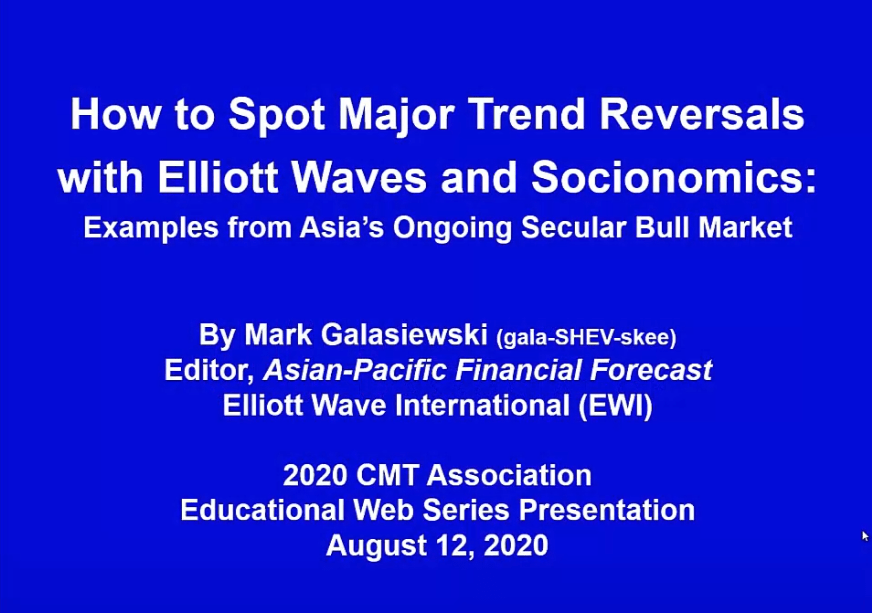From the Editor’s Desk
In recent issues I have repeatedly asked for input from the membership, and this month you see that the response has been very positive. On the cover, we present a rather detailed piece by Joe Russo in which he analyzes several world markets. For many, the most interesting part of this article will be his comparison of arithmetic versus logarithmic scaling on charts. Joe raises several interesting points, and supports his ideas with examples. It’s exactly the kind of work that needs to be done in technical analysis. For reasons I have never understood, chart scaling can become an emotional topic among technicians. Joe simply presents facts with charts, the essence of technical analysis at it’s finest. Kim Husebye, CFA, CMT, also combines facts and charts in a shorter piece, fully exploring the Kondratieff Wave, an interesting theory familiar to most technicians. Kim’s short analysis should lead to some tradable insights with only a little thought. After entering a trade based upon your interpretations of one of those articles, Matthew Caruso presents some thoughts on when to exit aTo view this content you must be an active member of the TAN Association.
Not a member? Join the TAN Association and unlock access to hundreds of hours of written and video technical analysis content, including the Journal of Technical Analysis and the Video Archives. Learn more about Membership here.
What's Inside...
From the Executive’s Desk
by Tom SilveriMTA Members And Affiliates, As we rapidly approach the Holiday season, we often reflect on the year just past and think about the year ahead of us. At the MTA Headquarters, we are not different. We...
Scaling Perceptions In The Global Equity Boom
by Joseph RussoLONG TERM TREND CHANNELS Price Channel Analysis is a highly effective method by which to monitor key pivot points, trajectories, and the general boundaries within a given trend. No matter the time...
The Kondratieff Wave
by Kim Husebye, CFA, CMTNikolai Kondratieff (1892 – 1938) was a Russian economist who postulated that capitalist economies displayed long wave cycles of boom and bust of approximately 60 years’ duration. The Kondratieff...
The Astute Investor
by Scott G. Richter, CMT, CFA, CHPThe Astute Investor is an enlightening work by Dr. Eric L. Prentis. The book is a current era effort to build on the work done by Ben Graham in his day with The Intelligent Investor. While the title...
Learning When To Take Profits
by Matthew Caruso, CMTWhen traders learn about technical analysis, they most often learn how to use indicators and how to read chart patterns in order to enter a trade. The topic of how to exit a winning trade is often...
MTA Members And Affiliates,
As we rapidly approach the Holiday season, we often reflect on the year just past and think about the year ahead of us. At the MTA Headquarters, we are not different. We look back at this last year as a period of significant and often negative tumultuous change. It was not an easy period for the MTA—personal relationships became strained, process improvements were put into a state of flux and the Association changed many of its leadership positions. However, having worked through our required adjustments, we enter 2007 confident that our active Board, our specific process-change initiatives underway and our strategic vision for the future. Exciting times are ahead for the MTA in 2007 and your Headquarters staff enters 2007 with the enthusiasm and the vision to serve our MTA members and affiliates better than ever before in our history. We will not rest until this is
To view this content you must be an active member of the TAN Association.
Not a member? Join the TAN Association and unlock access to hundreds of hours of written and video technical analysis content, including the Journal of Technical Analysis and the Video Archives. Learn more about Membership here.
Contributor(s)

Tom Silveri
Bio
LONG TERM TREND CHANNELS
Price Channel Analysis is a highly effective method by which to monitor key pivot points, trajectories, and the general boundaries within a given trend. No matter the time frame, from 60-minutes to 60-years, applying price channel analysis yields an accurate account of trend integrity. Channeling price data also happens to be one of the essential components of Elliott Wave Theory. Channeling is the only way in which to monitor the classic five-wave impulse pattern identified by Elliott.
PERCEPTIONS
Value is clearly a subjective perception. General investment postures (long, short, or fl at) are contingent upon an (assumed accurate) perception that future values will continue to rise, go nowhere, or fall.
As such, price charts are essential in monitoring the present and historical nature in which the marketplace collectively perceives value. In this vein, it is critical to be aware of how the chart data under observation has been scaled. This
To view this content you must be an active member of the TAN Association.
Not a member? Join the TAN Association and unlock access to hundreds of hours of written and video technical analysis content, including the Journal of Technical Analysis and the Video Archives. Learn more about Membership here.
Contributor(s)

Joseph Russo
Publisher & Chief Market Analyst, Elliott Wave Technology. Joe has been studying Elliott Wave Theory and technical analysis of financial markets since 1991. He can be reached at
Nikolai Kondratieff (1892 – 1938) was a Russian economist who postulated that capitalist economies displayed long wave cycles of boom and bust of approximately 60 years’ duration. The Kondratieff wave cycle goes through four distinct phases of inflation (spring), stagflation (summer), disinflation (autumn) and deflation (winter). His study centered on prices and interest rates since the 1700’s, but interestingly, cycles of war, peace, famine and prosperity.
True to K-Wave prediction, deflation last took hold in the 1930’s, and long-term interest rates declined to a cycle low of 2.44% in 1946. Inflation subsequently followed from 1949-1966, then stagflation from 1966-1982. Long-term interest rates finally peaked at 13% in 1981, after rising for thirty-five years.
Disinflation commenced thereafter and continued until 2000, when stock markets topped out worldwide. Now we are in the winter deflation cycle which, according to Kondratieff theory, will be heralded by a general contraction of money, credit and asset prices.
To view this content you must be an active member of the TAN Association.
Not a member? Join the TAN Association and unlock access to hundreds of hours of written and video technical analysis content, including the Journal of Technical Analysis and the Video Archives. Learn more about Membership here.
Contributor(s)

Kim Husebye, CFA, CMT
Kim Husebye, CFA, CMT is licensed as an Investment Advisor and Portfolio Manager in the province of Ontario, and has more than twenty years’ experience in brokerage and investment management. Kim graduated from the University of Toronto with a Bachelor of Science and double...

The Astute Investor is an enlightening work by Dr. Eric L. Prentis. The book is a current era effort to build on the work done by Ben Graham in his day with The Intelligent Investor. While the title tagline “the secrets to make you rich”, is a bit frothy, I do believe this book allows every investor the opportunity to revisit and hone their understanding of the key dimensions of the financial markets.
That being said – what is this book all about? It is a system – both strategic and tactical – to win in the markets. Does it work? Well, to each his own (I use a fusion analysis myself). As to the results, I’ll leave it up to you to test the system (Dr. Prentis also manages money – you could test it with him as well).
Here’s what I liked
To view this content you must be an active member of the TAN Association.
Not a member? Join the TAN Association and unlock access to hundreds of hours of written and video technical analysis content, including the Journal of Technical Analysis and the Video Archives. Learn more about Membership here.
Contributor(s)

Scott G. Richter, CMT, CFA, CHP
Scott Richter, CMT, CFA, CHP is a senior portfolio manager for Westfield, which manages over $4B in AUM. He is the lead portfolio manager for alternative assets and is also responsible for investments in the energy and utility sectors. He was formerly the co-manager...
When traders learn about technical analysis, they most often learn how to use indicators and how to read chart patterns in order to enter a trade. The topic of how to exit a winning trade is often ignored and as a result, many traders exit their trades too early or too late, giving up potential profit. Many traders use subjective points, or exit at price targets generated by chart patterns and point and figure charts. Although these are all valid forms of exit, perhaps an approach based on statistical measures would help to improve the timing of when to exit a trade.
The ever popular Bollinger Bands are bands that expand and contract according to a security’s volatility. The bands are placed two standard deviations from the security’s 20 day moving average. Standard deviations measure the dispersion of a set of data from its mean. Two standard deviations from the mean
To view this content you must be an active member of the TAN Association.
Not a member? Join the TAN Association and unlock access to hundreds of hours of written and video technical analysis content, including the Journal of Technical Analysis and the Video Archives. Learn more about Membership here.
Contributor(s)

Matthew Caruso, CMT
Matthew Caruso, CMT is a senior pro equity trader for National Bank financial as well as president of the Canadian Society of Technical analysts. He is past adjunct professor and co-creator of Canada’s first fully accredited technical analysis course at Concordia University...
New Educational Content This Month
-
August 26, 2020
The CMT Experience
Presenter(s): Tyler Wood, Dave Lundgren, CMT, CFA
-
August 26, 2020
Reading the Current Market in Light of History’s Lessons
Presenter(s): Ryan Detrick, CMT
-
August 12, 2020
How to Spot Major Trend Reversals with Elliott Waves and Socionomics: Examples from Asia’s Ongoing Secular Bull Market
Presenter(s): Mark Galasiewski



